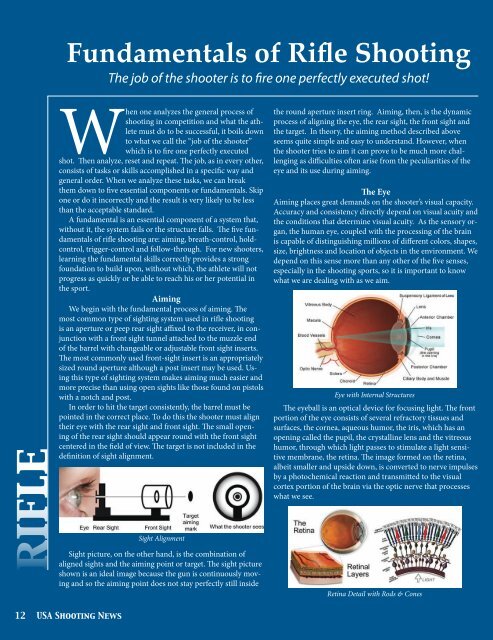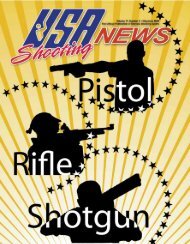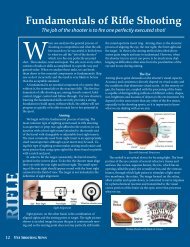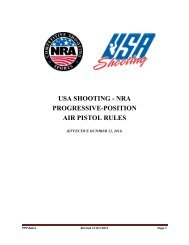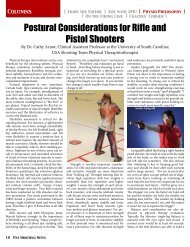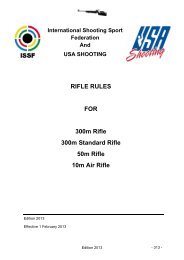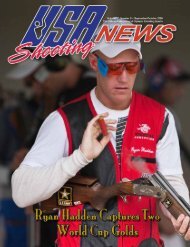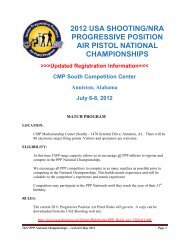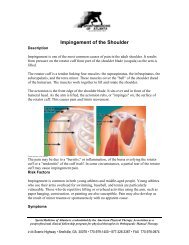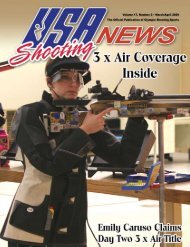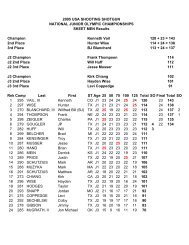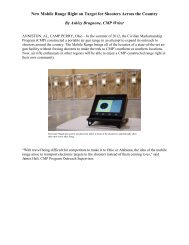Fundamentals of Rifle <strong>Shooting</strong>The job of the shooter is to fire one perfectly executed shot!rifleWhen one analyzes the general process ofshooting in competition and what the athletemust do to be successful, it boils downto what we call the “job of the shooter”which is to fire one perfectly executedshot. Then analyze, reset and repeat. The job, as in every other,consists of tasks or skills accomplished in a specific way andgeneral order. When we analyze these tasks, we can breakthem down to five essential components or fundamentals. Skipone or do it incorrectly and the result is very likely to be lessthan the acceptable standard.A fundamental is an essential component of a system that,without it, the system fails or the structure falls. The five fundamentalsof rifle shooting are: aiming, breath-control, holdcontrol,trigger-control and follow-through. For new shooters,learning the fundamental skills correctly provides a strongfoundation to build upon, without which, the athlete will notprogress as quickly or be able to reach his or her potential inthe sport.AimingWe begin with the fundamental process of aiming. Themost common type of sighting system used in rifle shootingis an aperture or peep rear sight affixed to the receiver, in conjunctionwith a front sight tunnel attached to the muzzle endof the barrel with changeable or adjustable front sight inserts.The most commonly used front-sight insert is an appropriatelysized round aperture although a post insert may be used. Usingthis type of sighting system makes aiming much easier andmore precise than using open sights like those found on pistolswith a notch and post.In order to hit the target consistently, the barrel must bepointed in the correct place. To do this the shooter must aligntheir eye with the rear sight and front sight. The small openingof the rear sight should appear round with the front sightcentered in the field of view. The target is not included in thedefinition of sight alignment.Sight AlignmentSight picture, on the other hand, is the combination ofaligned sights and the aiming point or target. The sight pictureshown is an ideal image because the gun is continuously movingand so the aiming point does not stay perfectly still insidethe round aperture insert ring. Aiming, then, is the dynamicprocess of aligning the eye, the rear sight, the front sight andthe target. In theory, the aiming method described aboveseems quite simple and easy to understand. However, whenthe shooter tries to aim it can prove to be much more challengingas difficulties often arise from the peculiarities of theeye and its use during aiming.The EyeAiming places great demands on the shooter’s visual capacity.Accuracy and consistency directly depend on visual acuity andthe conditions that determine visual acuity. As the sensory organ,the human eye, coupled with the processing of the brainis capable of distinguishing millions of different colors, shapes,size, brightness and location of objects in the environment. Wedepend on this sense more than any other of the five senses,especially in the shooting sports, so it is important to knowwhat we are dealing with as we aim.Eye with Internal StructuresThe eyeball is an optical device for focusing light. The frontportion of the eye consists of several refractory tissues andsurfaces, the cornea, aqueous humor, the iris, which has anopening called the pupil, the crystalline lens and the vitreoushumor, through which light passes to stimulate a light sensitivemembrane, the retina. The image formed on the retina,albeit smaller and upside down, is converted to nerve impulsesby a photochemical reaction and transmitted to the visualcortex portion of the brain via the optic nerve that processeswhat we see.Retina Detail with Rods & Cones12 <strong>USA</strong> <strong>Shooting</strong> NewsNov-Dec Issue <strong>2010</strong>.indd 1211/8/10 9:22 PM
In order to see the world around us clearly, the imageformed on the retina must be sharp. The normal eye at rest(or relaxed) is focused at infinity, so distant objects appear infocus, but nearby objects appear out of focus. To see closerobjects clearly, the ciliary muscle contracts reflexively tochange the shape of the crystalline lens to a more convex formincreasing the refractive power and bring the near object intofocus on the retina. This ability is called accommodation.Distant objects will now be out of focus. The eye cannot clearlyfocus on objects located at different distances at the same instant.While the reflex action of accommodation can take placequickly (especially in younger people when the crystalline lensis quite flexible) this puts a strain on the visual apparatus andmust be avoided.The eye also responds automatically to varying amounts ofambient light, by opening or closing the pupil via another reflexiveaction of the group of smooth muscles that controls theiris. This dilation or contraction of the pupil, called adaptation,regulates the amount of light entering the eye. The normalpupil opening ranges from a maximum of approximately eightmillimeters to a minimum of two or three millimeters. As weage, the maximum opening decreases to six millimeters makingit more difficult for older people to see at night. The pupilopening adapts much more quickly to increased illumination(a few seconds) than it does to a decrease in illumination(a few minutes). Therefore, it is critical to avoid looking atbrightly illuminated objects before or during shooting, and amajor reason flash photography is not permitted during shootingcompetitions.The action of the pupil is similar to the f-stop in a camera.The depth of field or the range of distances that the camera(eye) sees as being in focus increases as the f-stop aperture(pupil) size becomes smaller. The artificial pupil of the fixedrear aperture, or an adjustable rear iris, takes advantage of thisthereby allowing the shooter to increase the depth of field soall the elements of the sight picture are clearly seen in focus.Imperfections of the EyeAs a result of optical imperfections of the various componentsof the eye, the edges of the image produced on the retinaare not always perfectly clear. This is the ultimate limit of theresolution of the eye or visual acuity. However, under differingconditions of ambient light and/or fatigue, visual acuity is notconstant and can change.There are several inherent phenomena that occur as a resultof the eye being an optical instrument. The first is sphericalaberration, which occurs when parallel rays of light passingthrough the crystalline lens are refracted differently and thusnot focused at a single place on the retina. Light passing nearthe edge of the pupil, farther from the center of the opening,are refracted more than those passing through the center. Thisappears as a circle of diffused light rather than a sharp image.Spherical aberration is at a maximum when the pupil is openthe most. Image clarity can be improved if one can eliminatethe outer rays by either contracting the pupil or using an artificialpupil like that on the rear sight.Spherical AberrationA related problem is chromatic aberration. Visible lightis made of all the colors of the spectrum. When visible lightpasses through a lens, light in the blue and violet region refractsmore than that in the orange and red region of the spectrumfocusing each color at a slightly different point, causinga fringe or margin of colors to appear around the edges of theimage, especially around bright objects. This occurs becauselenses have different refractive indexes for different wavelengthsof light. Eliminating or reducing the amount of shorterwavelength (blue) light by a filter can improve image clarity.Chromatic AberrationAnother phenomenon occurs when light passes throughsmall openings, like the pupil or rear aperture, the rays bendand produce an image on the retina that is not a single point,but a circle surrounded by a number of concentric light anddark rings of decreasing brightness. This is called light diffractionand is due to the wave nature of light. Diffractionrings are only noticeable when the pupil is very small and isthe opposite of the cause of spherical aberration (large pupil).Diffraction effects are more noticeable when bright light isshining into the eyes causing the pupil to contract. Anotherdemonstration of diffraction is found when looking through asmall aperture. Looking carefully at the center of the opening,there seems to be a faint grey ring floating there, it is not dirtor fuzz, it is the diffraction pattern of the light.Light can also be diffused as it passes through the variouseye media, which are not absolutely transparent. Light diffusionmanifests itself as a radiance or weakly luminous hazecovering the field of vision, and is especially noticeable as ahalo of light around brightly illuminated objects against a darkbackground or when bright light enters the eye directly.Light irradiation is probably more applicable to pistolriflewww.usashooting.org 13Nov-Dec Issue <strong>2010</strong>.indd 1311/8/10 9:22 PM


